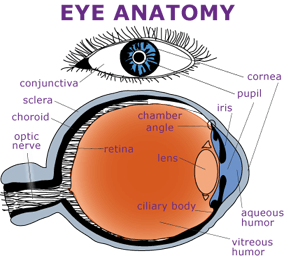Requirement for receiving disability for Legal Blindness
 According to an April 2011 report from the American Academy of Ophthalmology, more than one million people in the United States over the age of 40 are legally blind. Most of you have heard the term “legally blind” but you likely don’t know what qualifies a person for disability benefits due to severe vision problems. Legal blindness is defined in two sections of the Social Security Act: § 216(i)(B) (codified at 42 U.S.C. § 416(i)(B)) and § 1614(a)(2) (codified at 42 U.S.C. § 1382c(a)(2)). Both sections of the Act define “blindness” as: central visual acuity of 20/200 or less in the better eye with the use of a correcting lens. An eye which is accompanied by a limitation in the fields of vision such that the widest diameter of the visual field subtends an angle no greater than 20 degrees shall be considered for purposes of this paragraph as having a central visual acuity of 20/200 or less.
According to an April 2011 report from the American Academy of Ophthalmology, more than one million people in the United States over the age of 40 are legally blind. Most of you have heard the term “legally blind” but you likely don’t know what qualifies a person for disability benefits due to severe vision problems. Legal blindness is defined in two sections of the Social Security Act: § 216(i)(B) (codified at 42 U.S.C. § 416(i)(B)) and § 1614(a)(2) (codified at 42 U.S.C. § 1382c(a)(2)). Both sections of the Act define “blindness” as: central visual acuity of 20/200 or less in the better eye with the use of a correcting lens. An eye which is accompanied by a limitation in the fields of vision such that the widest diameter of the visual field subtends an angle no greater than 20 degrees shall be considered for purposes of this paragraph as having a central visual acuity of 20/200 or less.
To qualify for Social Security disability under the umbrella of blindness due to a lack of visual acuity, you will need to start by obtaining a basic eye examination that provides measurements of your best-corrected visual acuity. Simply having myopia does not qualify you for disability, if it did, over 32 million Americans older than 40 would be receiving benefits.
Nor is simple visual impairment, defined as being capable of at best 20/40 vision even with corrective lenses, enough to qualify for benefits. To be declared legally blind by the SSA, you need to prove that even with the best possible corrective lenses, your best eye can only achieve 20/200 visual acuity. In other words, even the good eye can only see an object sitting 20 feet away as clearly as someone with perfect 20/20 vision can see that same object if it were 200 feet away.
Another somewhat surprising way to qualify for disability due to blindness is through a severely diminished visual field, basically no peripheral vision. A person with a healthy visual field can typically see at least 60 degrees in all direction without moving his or her eyes. Those who qualify for legal blindness due to loss of visual field cannot see more than 20 degrees in any direction. In other words, the person afflicted has almost completely lost his peripheral vision, something that is usually a symptom of other problem such as glaucoma. Again, the best place to start is with a standard eye examination which will reveal the extent of your visual field.
Unlike most other reasons for receiving Social Security disability, documentation of the cause of the statutory blindness is not required, as long as it is something detectable with a basic eye examination. For blindness caused by abnormalities not readily observed from a standard eye examination, such as traumatic brain injury to the visual cortex, documentation of the source of the injury must be provided. Also unlike many other bases of disability, you do not need to prove that this blindness has been present for any particular length of time, the fact that you are afflicted now is all that matters.
If you think you may be entitled to Social Security Disability benefits and have questions, call The Law Offices of John T. Nicholson at 1-800-596-1533 for consultation today.


I am legally blind and I have problem at my computer at work. Can I file for disabilty? I have corrective lenses but still at night my vision is impaired and I need to travel at night home after 5 pm. With corrective lenses, I can see 20/40 only
My wife is 68 can she get any benefits and will she get my ss when I die?
My daughter is 12 and is legally bind does she qualify for benefits?